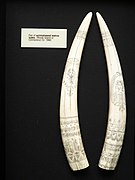Walrus ivory
Walrus ivory or walrus tooth is the name given to the tusks of a walrus . These can be up to about one meter long.
history
Since the colonization of the Arctic, walrus ivory has been used by the peoples there, as building material, for cultic or other purposes.
With the beginning of the metal age , the importance of walrus teeth for tool manufacture gradually declined. Those peoples who traditionally hunted walruses, for example the Inuit , Inupiaq , Yupik , Chukchi and Koryaks, were used to using all parts of the hunted animals. The teeth were increasingly used for jewelry and art objects. This resulted in high-quality artistic objects. To this day, z. B. over 3,000 year old pictorial representations of whaling on walrus teeth from the Chukchi Sea .
Around the year 500, the importance of walrus ivory as a commodity rose by leaps and bounds, as the Byzantine Empire hardly supplied elephant ivory to Europe, but used it itself. The Vikings took over the trade and used them to decorate their helmets as status symbols. Since the 8th century, after the Muslim conquest of North Africa, there were no deliveries from the Orient at all , so that in the 11th and 12th centuries only walrus ivory was practically available in the Anglo-Saxon and Northern European regions.
With the onset of colonialism , the importance of walrus ivory declined rapidly, as elephant ivory was again being delivered to Europe in large quantities via Valencia and Lyon , the hubs of the global ivory trade at the time.
In Russia, walrus hunting no longer had any significant economic importance in the 1960s. The populations were estimated at about 300,000 Pacific and about 50,000 Atlantic walruses at the end of the 1980s.
In 1973, with the Washington Convention on the Protection of Species, the hunting of walrus populations at risk was initially prohibited; Since then this is only allowed to the Eskimos . Very similar regulations were introduced in Russia in 1975. Since 1979, there have been additional import bans on walrus ivory in the signatory countries in order to put a stop to poaching and trophy hunting .
present
Trade in walrus ivory has been restricted by the United Nations , which is contributing to a marked recovery in stocks. As a result, global trade has practically come to a standstill. However, for some Nordic peoples who are still allowed to hunt, the manufacture and sale of ivory carvings have remained an important source of income to this day. Particularly noteworthy here are filigree knife and pistol handles, which are traded in hunting and collecting circles at prices that often increase the market value of the edged and firearms decorated with them by a power of ten. Additional sources of income are generated from the leasing of hunting licenses from the natives to tourist big game hunters. These days they achieve around 8% of the shooting rates and often circumvent the import bans imposed in their home countries by making casts of their hunting trophies (prey skulls). Today, for reasons of prestige , only the stately and often very old lead bulls of the respective walrus colonies are hunted , who often even sacrificially swim towards the heavily armed, so-called courageous hunters to defend their colonies.
art
Arctic peoples
The arctic peoples used walrus ivory to make high-quality workmanship and carvings. Today there is high commercial interest in works of art made of walrus ivory (see Tupilak ).
Tupilak , Greenland
In the British Isles and Scandinavia, everyday objects such as knife handles, hairbrushes, shoehorns and cufflinks made of walrus ivory have also been produced since the early Middle Ages. Book covers, crosses, figurative representations and chess pieces ( Lewis chess pieces ) and billiard balls are also known. The artistically carved pistol grips and stock inlays of hunting and dueling weapons have remained particularly popular and highly valued in aristocratic circles .
Reliquary Cross , England, 10th Century
literature
- Williamson, Paul, An Introduction to Medieval Ivory Carvings , Victoria and Albert Museum London 1982, ISBN 0-11-290377-0
Web links
Individual evidence
- ↑ see e.g. B. Chester S. Chard, Eskimo Archeology in Siberia , in: Southwestern Journal of Anthropology , Vol. 11, 1955, No. 2
- ↑ Whaling drawings on walrus ivory
- ↑ Stock figures around 1980
- ↑ Walrus hunting in the Arctic
- ↑ Walrus ivory weapon handles
- ↑ Walrus hunting in the Arctic













